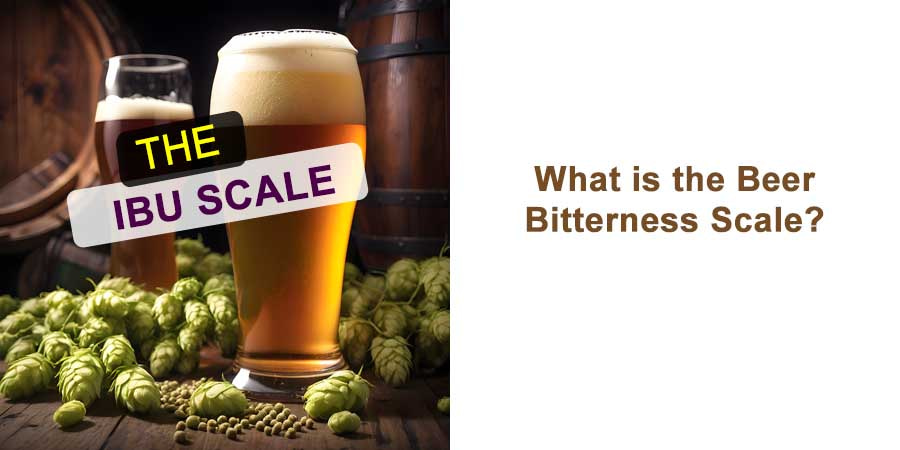
Last Updated on April 24, 2024 by Doug Hall
Understanding the Beer Bitterness Scale: Exploring IBU
If you’re a beer enthusiast, you may have heard people discussing the bitterness level of different beers or come across the term IPA (India Pale Ale).
There was an explosion of popularity in IPAs and bitter beers in the early 2000s. Much of the credit goes to the fertile grounds in the Pacific Northwest that introduced the now familiar bitter, citrus flavor profile of newer hop varieties. Centennial, Citra, and Cascade are a few known as the ‘C’ hops.

Despite their recent popularity, India Pale Ales (IPA) have been around for centuries. It was early European sailors who had trekked all the way around the southern tip of Africa to get to the silk trade ports of India. They discovered that adding more hops allowed the beer to stay fresh long enough to drink through their long journey. It certainly stayed fresh longer than barrels of water. Thus, the name India Pale Ale was born.
But have you ever wondered how this bitterness is measured and quantified? Enter the Beer Bitterness Scale, also known as the International Bitterness Units (IBU).
What is the International Bitterness Units (IBU)?
The International Bitterness Units (IBU) is a measurement scale used to quantify the bitterness of beer. It provides a standardized method for brewers and beer enthusiasts to communicate and evaluate the perceived bitterness in various beer styles.
How is IBU Measured?
The IBU scale is based on the concentration of bittering compounds, primarily alpha acids, found in hops—the flowers of the Humulus lupulus plant often used in brewing. To measure IBUs, a sample of beer is tested using spectrophotometry or high-performance liquid chromatography (HPLC) to determine the concentration or levels of these bittering compounds.
McGill University Office for Science and Society published an awesome article further explaining how IBU is measured.
Understanding the IBU Scale
The IBU scale ranges from 0 to 100 or even higher. Beers with lower IBU values typically have a milder and less pronounced bitterness, while those with higher IBU values have a more intense and lingering bitterness.
Interpreting IBU Values
- Low IBU (0-20): Beers with a low IBU range are generally categorized as lighter, milder, and less bitter. Examples include German wheat beers (Hefeweizens), Belgian Witbiers, or light lagers. These beers tend to focus more on malt sweetness and have a balanced and approachable flavor profile.
- Medium IBU (20-40): Beers falling within this range strike a balance between bitterness and other flavors. Many popular beer styles, including American Pale Ales (APAs), Amber Ales, and some IPAs, fall into this category. These beers offer a noticeable bitterness but still maintain a pleasant balance with maltiness and hop flavor.
- High IBU (40+): Beers on the higher end of the IBU scale tend to showcase a pronounced bitterness. These include India Pale Ales (IPAs), Double IPAs (DIPAs), Imperial Stouts, and some Belgian Tripels. With bold hop flavors and a substantial bitterness, these beers cater to enthusiasts seeking intense and resinous hop characteristics.
One thing to consider is that many IPAs, to achieve a high IBU value, tend to require a lot of fermentable sugars. In other words, many stronger IPSs also have stronger alcohol content.

I recently brewed an Imperial Pale Ale, also known as a Double IPA. The recipe said the final ABV was going to be around 8%. I am not a huge fan of high-alcohol beers, so I adjusted the grain bill as well as the hop additions. I ended up at 6.5% ABV with a true Imperial Pale Ale bitterness. You can read our Imperial Pale Ale recipe review here.
Considerations Beyond IBU
While IBU provides a useful indication of a beer’s bitterness, it’s important to remember that it’s just one factor among many that contribute to a beer’s overall taste. The perception of bitterness can be influenced by other elements such as residual sugar, malt sweetness, hop flavors, and other additives. Therefore, it’s essential to explore the complete flavor profile of a beer, taking into account its aroma, maltiness, hop character, and any other unique characteristics that contribute to its taste.
Conclusion
The International Bitterness Units (IBU) scale serves as a standardized measure of bitterness in beer. It allows brewers and enthusiasts to assess and communicate the perceived bitterness in various beer styles. Understanding the IBU scale can help you navigate the world of beer, enabling you to choose a brew that aligns with your personal preferences and taste preferences. So, next time you sip on a beer, take a moment to appreciate the unique balance between bitterness and other flavors that make it a delightful experience.
- Beer Yeast Substitution Chart - May 5, 2024
- Mango Kolsch Beer Recipe Review - May 2, 2024
- Helles Lager Beer Recipe Review - May 2, 2024
